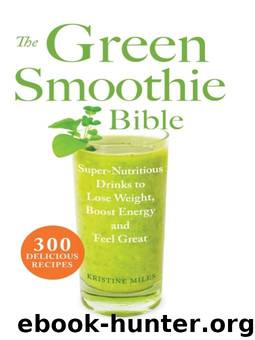The Green Smoothie Bible: 300 Delicious Recipes by Kristine Miles

Author:Kristine Miles [Miles, Kristine]
Language: eng
Format: epub, mobi
ISBN: 9781569759998
Publisher: Ulysses Press
Published: 2011-11-07T23:00:00+00:00
Antioxidants
Oxidation, degradation, corrosion, tarnishing, rusting—they all describe the breakdown of a substance due to a chemical reaction with its surroundings. The classic example is iron rusting into iron oxide when exposed to water. Because nature always seeks balance, or homeostasis, and energy conservation, the rusting of iron is nature’s way of returning the manufactured form of iron to the more stable state that exists in nature.
Antioxidant refers to anti-oxidation. “Oxidation” is a term used in chemistry to describe the net loss of electrons, which are tiny particles within an atom that have a negative charge (protons are positive). The opposite is “reduction,” which describes the net gain of electrons.
Nature’s desire for homeostasis results in redox (REDuction –OXidation) reactions, which occur continuously in nature and in the human body. For example, photosynthesis in plants involves the conversion of carbon dioxide, water, and sunlight energy into sugars that are stored in plants and the release of oxygen as a by-product. Human cellular respiration involves the opposite reaction, the conversion of glucose and oxygen into carbon dioxide, water, and energy. Each reaction has two parts, one part an oxidation reaction and one part a reduction reaction. Ideally, any free electron that detaches itself will reattach immediately. If it doesn’t, it becomes a free radical. Free radicals are unstable and seek out attachment to anything that can give them electrical balance. In the best-case scenarios, attachment occurs within a redox reaction or free radicals attach to and are neutralized by antioxidant substances. If neither scenario happens, then free radicals attach themselves to any surface they can, which can lead to cellular damage and a cascade of destruction, including cell mutation.
Degradation due to oxidation occurs not only in metals but also in the human body. Free radical formation in the body can be accelerated by external influences such as tobacco smoke, toxins, pollution, stress, and poor eating habits. Scientists have known for decades that free radical damage can be linked to cancer, cardiovascular disease, rheumatoid arthritis, diabetes, and age-related diseases.
A diet rich in antioxidants, which exist in plants and algae, is the ideal army to fight free radicals. Antioxidant substances include vitamins A, C, and E as well as selenium, coenzyme Q10, glutathione, flavonoids, polyphenols, and plant pigments such as chlorophyll and carotenoids.
ORAC (Oxygen Radical Absorbance Capacity) is a standardized measurement of the total antioxidant power of a food. Antioxidant power is the ability to neutralize free radicals. It is well known that many of the world’s developed countries have nutrient-deficient soils, particularly Australia, where I live. It is estimated that 70 percent of the population of developed countries is micronutrient malnourished. Thus nutritionists recommend consuming at least seven servings of fruits and vegetables per day, which will supply sufficient antioxidant activity in the body to reduce free radical damage. Seven servings of fruits or vegetables provide around 3,500 ORAC units, but my problem with this calculation is that not all fruits and vegetables are created equal. Seven servings of iceberg lettuce are different from seven servings of fresh berries.
Download
The Green Smoothie Bible: 300 Delicious Recipes by Kristine Miles.mobi
This site does not store any files on its server. We only index and link to content provided by other sites. Please contact the content providers to delete copyright contents if any and email us, we'll remove relevant links or contents immediately.
| Blenders | Bread Machines |
| Cast Iron | Dehydrators |
| Dutch Ovens | Fondue Pots |
| Food Processors | Fryers |
| Frozen Desserts | Juicers |
| Pressure Cookers | Rice Cookers |
| Slow Cookers | Woks |
Betty Crocker's Good and Easy Cook Book by Betty Crocker(2679)
Food and Water in an Emergency by Food & Water In An Emergency(2342)
Easy Rice Recipes: Learn New Creative Styles Like Spanish, Asian, Oven Baked, Bowls, and Much More by Press BookSumo(2242)
The Art of Making Gelato by Morgan Morano(2216)
Vegan Desserts by Hannah Kaminsky(2033)
Better Homes and Gardens: Wonder Pot by Better Homes & Gardens(2030)
The I Quit Sugar Cookbook by Sarah Wilson(2001)
Project Smoke by Steven Raichlen(1998)
2250 Pressure Cooker, Crock Pot, Instant Pot and Slow Cooking Recipes Cookbook: (Crock-Pot Meals, Instant Pot Cookbook, Slow Cooker, Pressure Cooker Recipes, Slow Cooking, Paleo, Vegan, Healthy) by Jamie Stewart(1952)
Smoke & Spice by Cheryl Alters Jamison(1884)
The Air Fryer Bible by Susan LaBorde & Elizabeth Hickman(1855)
Food Processor Perfection by America's Test Kitchen(1825)
Every Grain of Rice: Simple Chinese Home Cooking by Fuchsia Dunlop(1785)
The Jam and Marmalade Bible by Jan Hedh(1618)
Slow Cooking for Two: A Slow Cooker Cookbook with 101 Slow Cooker Recipes Designed for Two People by Mendocino Press(1613)
Sweetly Raw Desserts: Raw Vegan Chocolates, Cakes, Cookies, Ice Cream, and More by Heather Pace(1587)
The French Baker by Sébastien Boudet(1580)
The Wood Pellet Smoker and Grill Cookbook by Peter Jautaikis(1551)
Idiot's Guides - Pressure Cooking by Tom Hirschfeld(1530)
